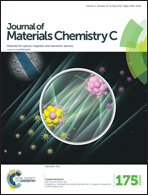Photon upconversion in Yb3+–Tb3+ and Yb3+–Eu3+ activated core/shell nanoparticles with dual-band excitation†
Abstract
Exploring novel lanthanide-activated upconversion nanoparticles with distinctive spectral fingerprints and emission lifetimes has long been a great concern for extended optical applications. Herein, we report the study of photon upconversion emissions in Yb3+–Tb3+ and Yb3+–Eu3+ activated nanoparticles with near-infrared excitation. In these nanoparticles, a high content of Yb3+ is required for the simultaneous excitation of two Yb3+ ions, yielding a Yb3+ dimer with a higher excited energy to upconvert photons onto Tb3+ and Eu3+. The optimum doping concentration of Yb3+ ions for Yb3+–Tb3+ and Yb3+–Eu3+ pairs was determined to be 80% and 60%, respectively, which are much higher than that of Yb3+–Er3+/Tm3+ pairs. Notably, the upconversion emission lifetime of the as-prepared nanoparticles was prolonged to 2.3 ms (Tb3+) and 4.0 ms (Eu3+), respectively. Through the epitaxial growth of a Nd3+ doped shell layer, the upconversion emissions of Tb3+ and Eu3+ were intensified 25-fold. At the same time, an extra excitation band in the shorter near-infrared region from Nd3+ at 808 nm was achieved. Moreover, the emissions of Tm3+ were employed to compensate for those of Tb3+ and Eu3+ for multicolor emissions. These results highlight the upconversion emissions of Tb3+ and Eu3+ for potential multicolor imaging and multiplexed detection applications.


 Please wait while we load your content...
Please wait while we load your content...